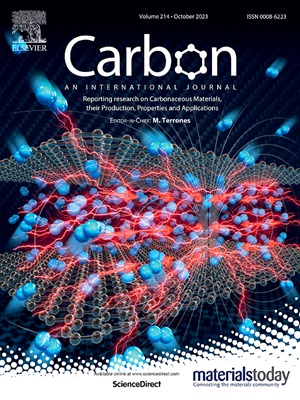可逆共价键辅助塑性拉伸:具有优越模量的氧化石墨烯薄膜的策略
IF 10.5
2区 材料科学
Q1 CHEMISTRY, PHYSICAL
引用次数: 0
摘要
由于氧化石墨烯薄片的不对准和薄膜中的皱纹,获得具有高机械性能的氧化石墨烯薄膜的努力受到了挫折。虽然塑料拉伸氧化石墨烯薄膜可以改善氧化石墨烯薄片的排列,平抑褶皱,但由于氧化石墨烯薄片之间的相互作用较弱且不稳定,在拉伸解除后,错位和褶皱会重新产生。在这项工作中,在氧化石墨烯薄片之间引入高强度共价键(C-O-B)来维持氧化石墨烯薄片的拉伸取向。优化后的材料断裂强度和杨氏模量分别提高了24.3%和110.3%,达到167.3 MPa和108.1 GPa。此外,在恶劣环境(85°C, 85%相对湿度,96小时)下,当在表面涂上一层薄薄的聚氨酯涂层以防止C- o - b共价键的水解时,制备的薄膜的性能仅表现出轻微的下降,这表明了实际应用的潜力。这种新策略有望扩展石墨烯、黑磷、MXene等其他层压材料的加工能力并提高其机械性能。本文章由计算机程序翻译,如有差异,请以英文原文为准。

Reversible Covalent Bond Assisted Plastic-stretching: a strategy towards Graphene Oxide Films with Superior Modulus
Efforts to obtain Graphene Oxide (GO) films with high mechanical properties have been frustrated by the misalignment of GO sheets and wrinkles in the films. While plastic-stretching GO films can improve the alignment of GO sheets and flatten the wrinkles, the misalignment and wrinkles regenerate after stretch release because of the weak and unstable interaction between GO sheets. In this work, high-strength covalent bonds (C-O-B) are introduced between GO sheets to maintain the stretch-induced orientation of GO sheets. After optimization, the fracture strength and Young’s modulus were respectively improved by 24.3% and 110.3% to 167.3 MPa and 108.1 GPa. Moreover, the as-prepared films exhibit only a marginal property degradation in harsh environments (85°C, 85% relative humidity, 96h) when applied a thin Polyurethane coating on the surface to prevent the hydrolysis of C-O-B covalent bond, which demonstrates the potential for practical applications. This new strategy is expected to extend the processing capability and enhance the mechanical properties of other laminated materials such as graphene, black phosphorus, MXene, and so on.
求助全文
通过发布文献求助,成功后即可免费获取论文全文。
去求助
来源期刊

Carbon
工程技术-材料科学:综合
CiteScore
20.80
自引率
7.30%
发文量
0
审稿时长
23 days
期刊介绍:
The journal Carbon is an international multidisciplinary forum for communicating scientific advances in the field of carbon materials. It reports new findings related to the formation, structure, properties, behaviors, and technological applications of carbons. Carbons are a broad class of ordered or disordered solid phases composed primarily of elemental carbon, including but not limited to carbon black, carbon fibers and filaments, carbon nanotubes, diamond and diamond-like carbon, fullerenes, glassy carbon, graphite, graphene, graphene-oxide, porous carbons, pyrolytic carbon, and other sp2 and non-sp2 hybridized carbon systems. Carbon is the companion title to the open access journal Carbon Trends. Relevant application areas for carbon materials include biology and medicine, catalysis, electronic, optoelectronic, spintronic, high-frequency, and photonic devices, energy storage and conversion systems, environmental applications and water treatment, smart materials and systems, and structural and thermal applications.
 求助内容:
求助内容: 应助结果提醒方式:
应助结果提醒方式:


